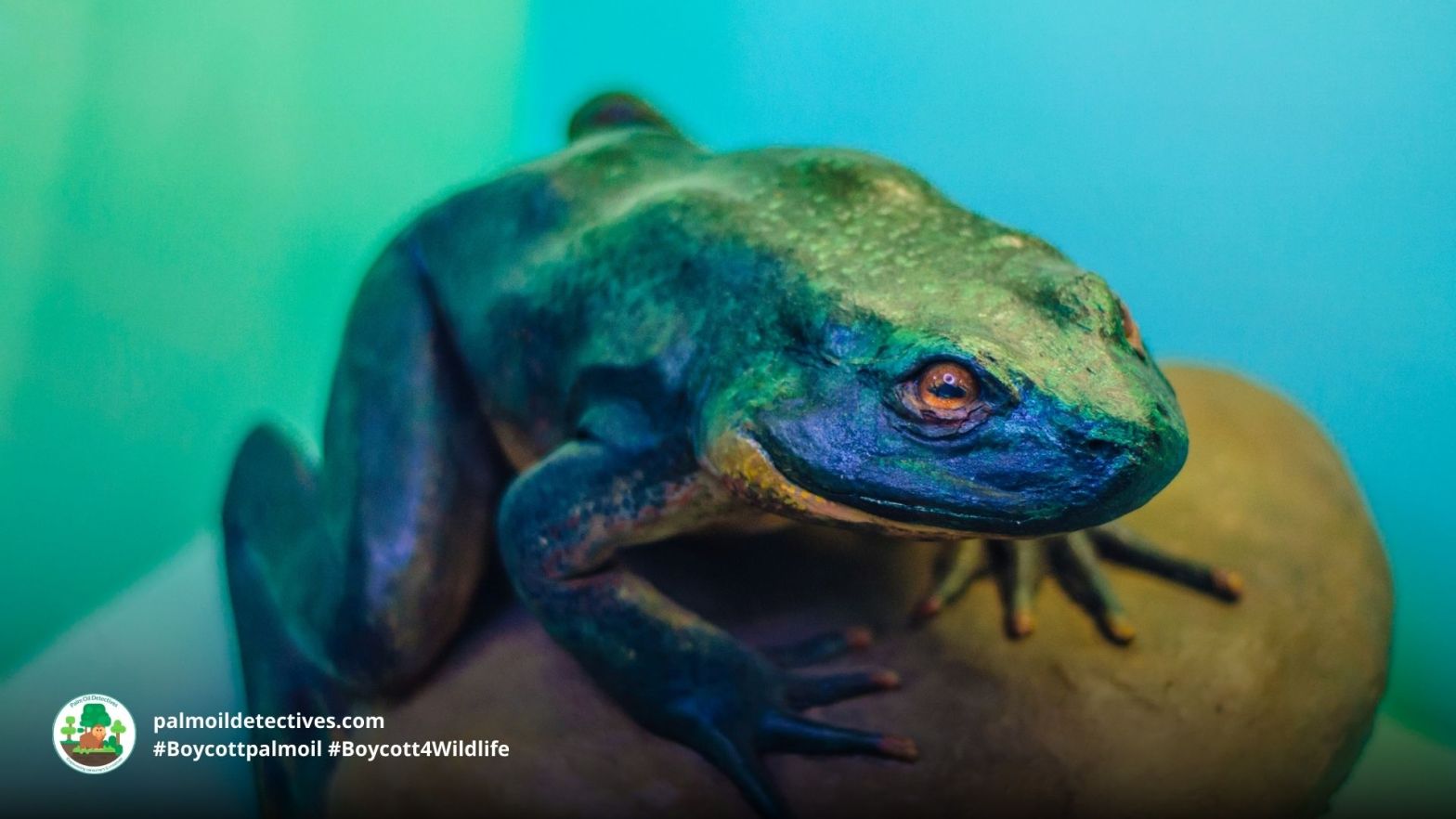Goliath Frog Conraua goliath
Endangered
Extant (resident)
Cameroon; Equatorial Guinea
Presence Uncertain
Gabon
Goliath Frogs are the largest frog in the world and can grow as large as a domestic cat. These muscle-bound #amphibians lift heavy rocks to build nests and protect their young. They face extinction from #palmoil #deforestation.
Their nesting and reproduction is hugely dependent upon access to clean, fast-flowing rivers – for this reason the encroachment of industrial scale palm oil, cocoa and timber deforestation and p0llution of rivers is a direct threat to the existence of the goliath frog. Help them every time you shop in the supermarket and #Boycottpalmoil #Boycott4Wildlife
Goliath Frogs are #endangered in #Gabon #Cameroon and Equatorial Guinea by #palmoil #deforestation and #hunting. Help them every time you shop and #Boycottpalmoil #Boycott4Wildlife
Tweet
Goliath Frogs are the largest frog in the world. These muscle-bound #amphibians lift heavy rocks to build nests. They face #extinction from #palmoil. Fight back against their extinction and use your wallet as a weapon #Boycottpalmoil #Boycott4Wildlife
Tweet
Appearance & Behaviour
The goliath frog gets their name from the fact that they are the largest extant frog in the world weighing between 600 grams to 3.2 kilos. Male and females appear almost the same with sexual dimorphism minimal. Despite their abnormally large size, their eggs and tadpoles are a similar size as other frogs. The skin on the back and upper side of their body is a rusty emerald green colour with limbs and underside a yellowish orange hue. They have excellent hearing but don’t possess a vocal sack, meaning that they don’t have a mating call – as do many other frog species.
The Goliath Frog is adversely affected by the loss of forest habitat for agriculture (including the creation of new cocoa plantations, banana plantations, and palm oil plantations), logging and human settlements.
Read more
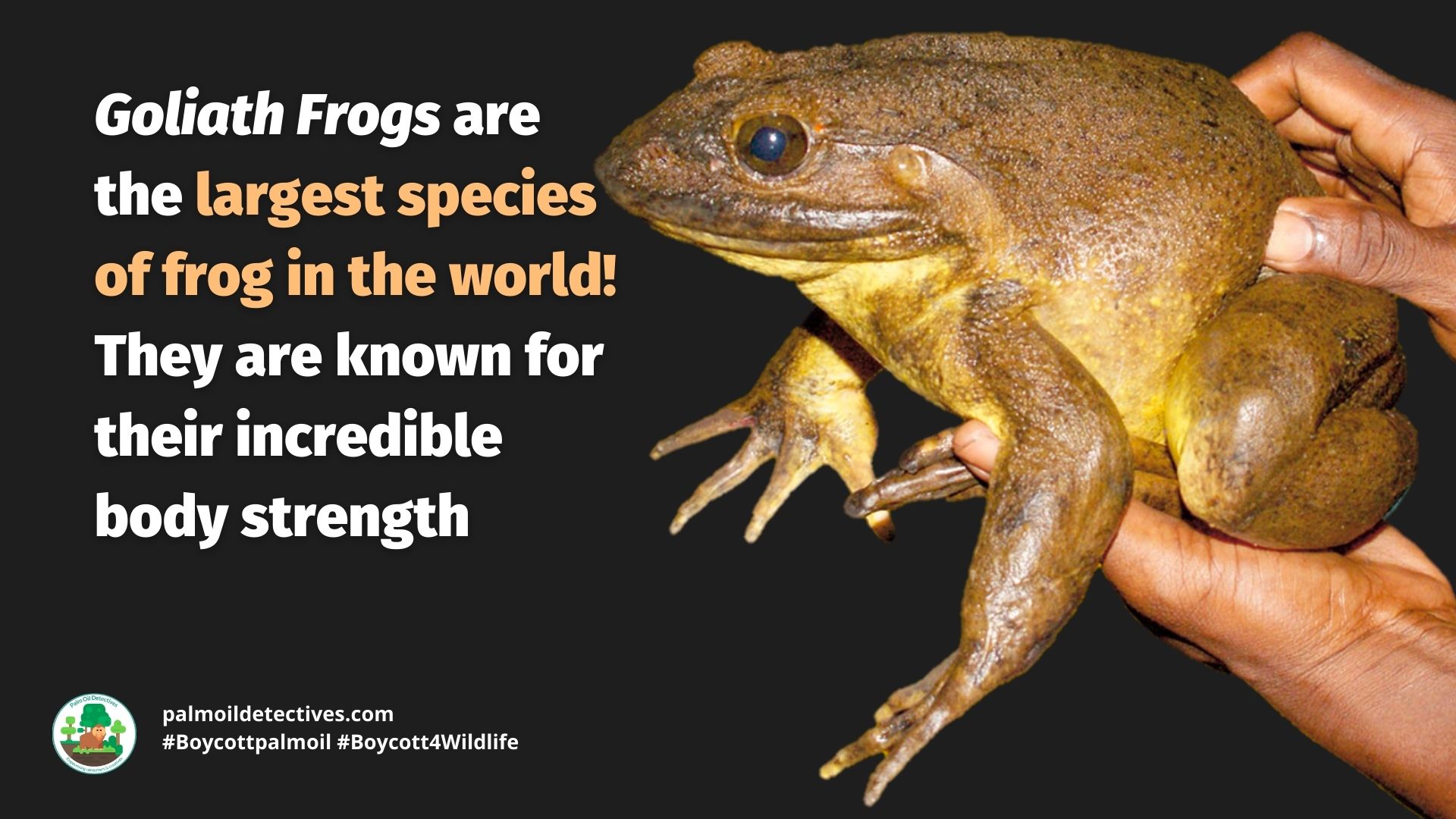


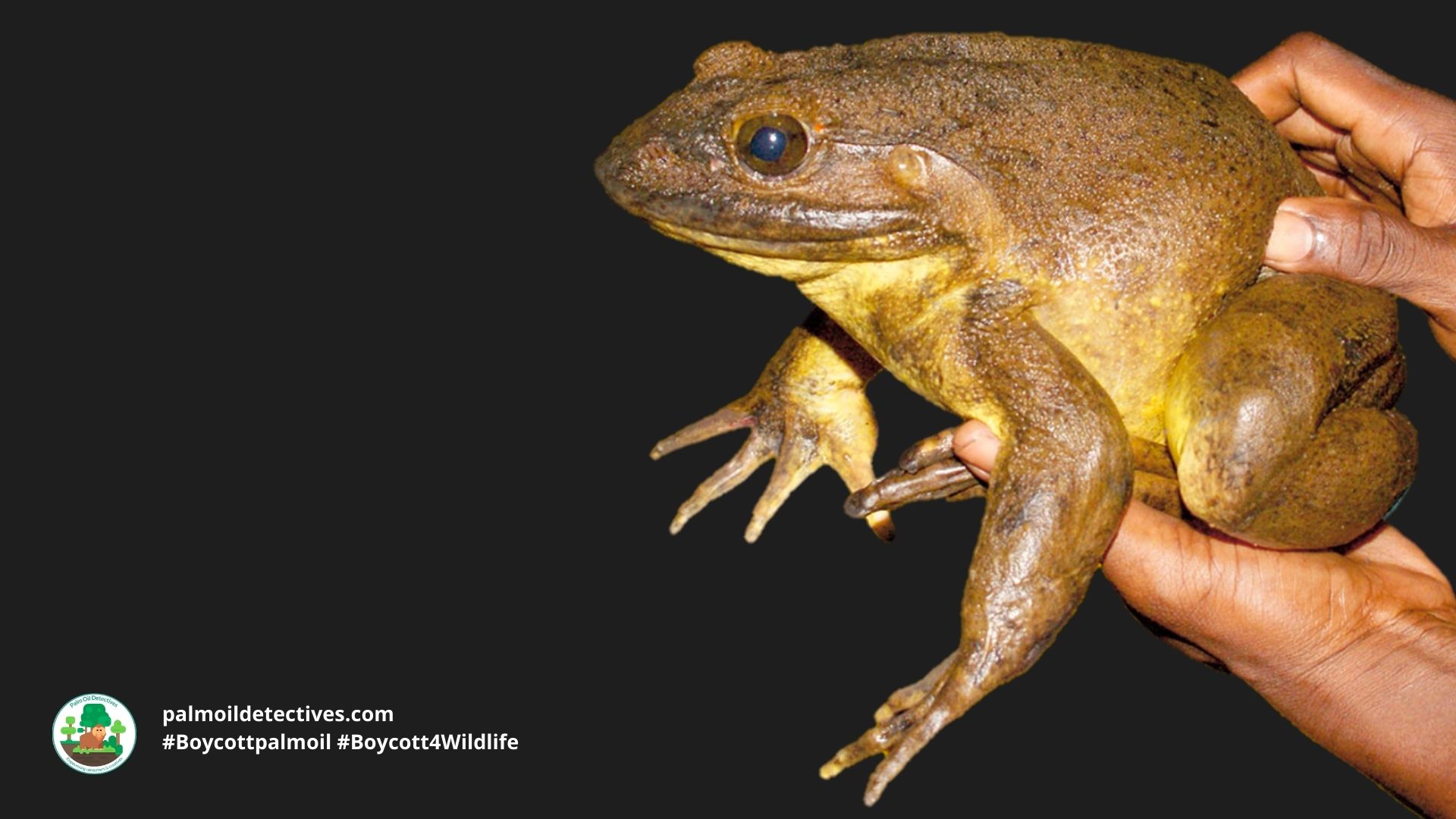
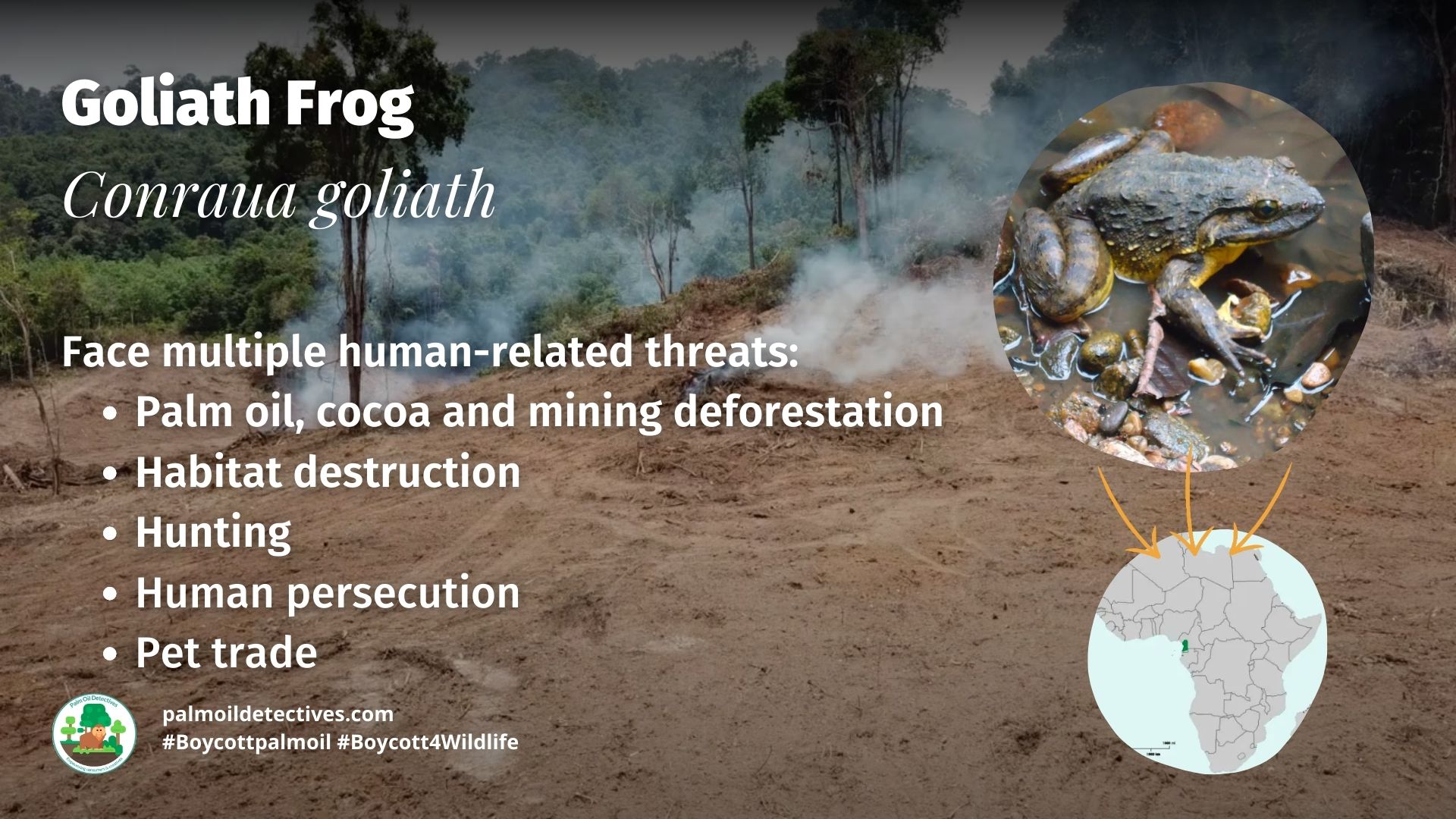
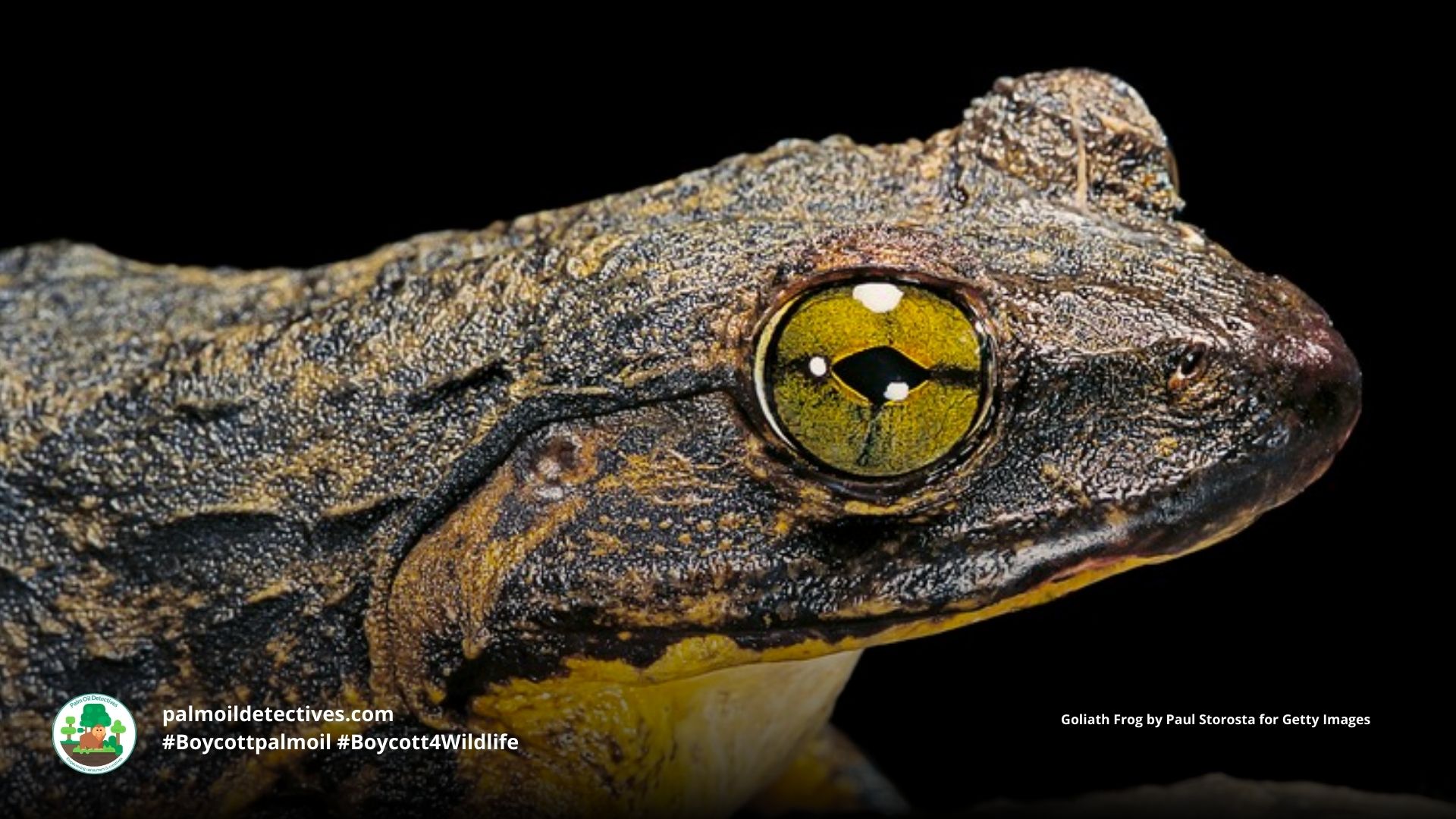
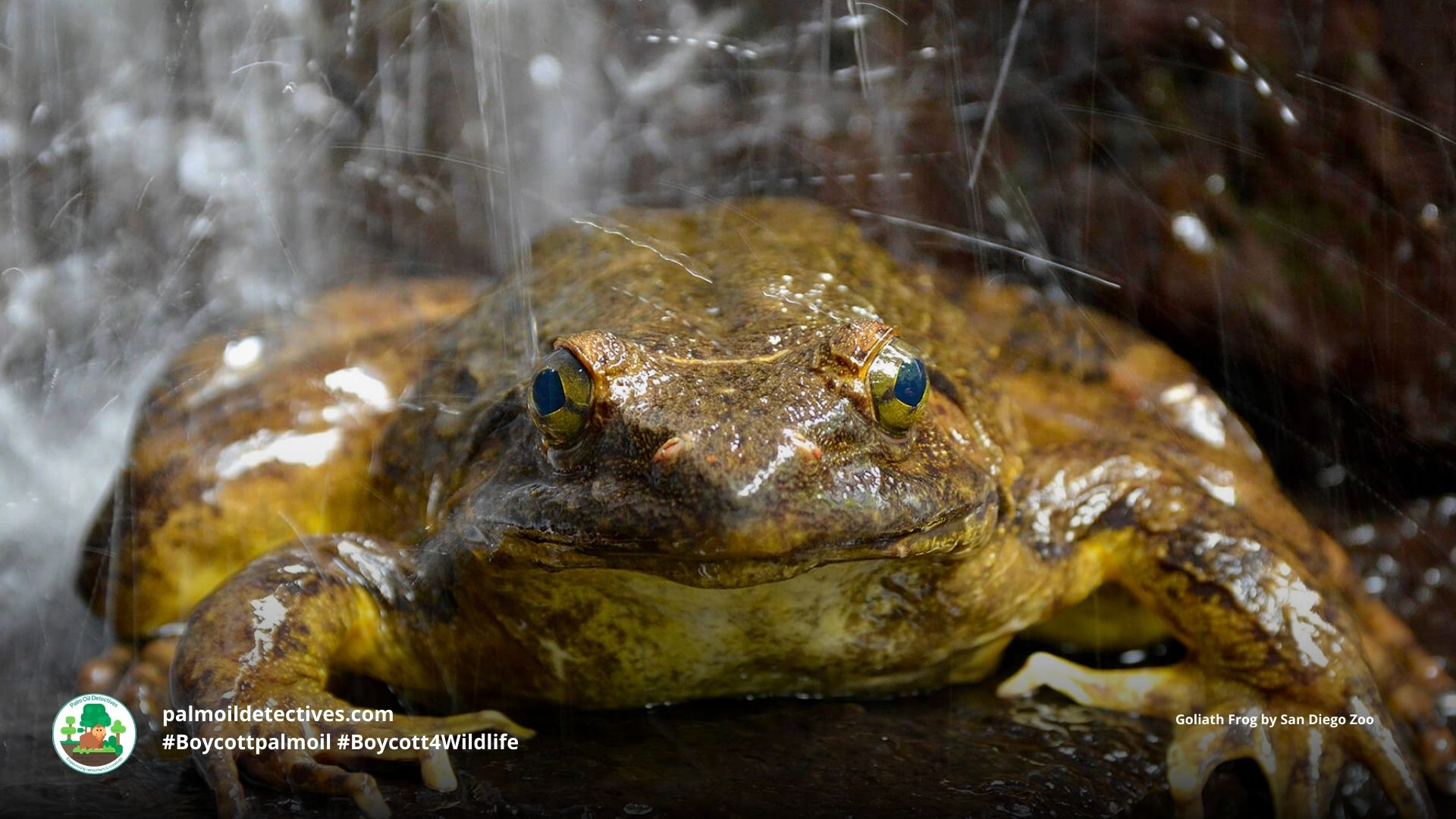
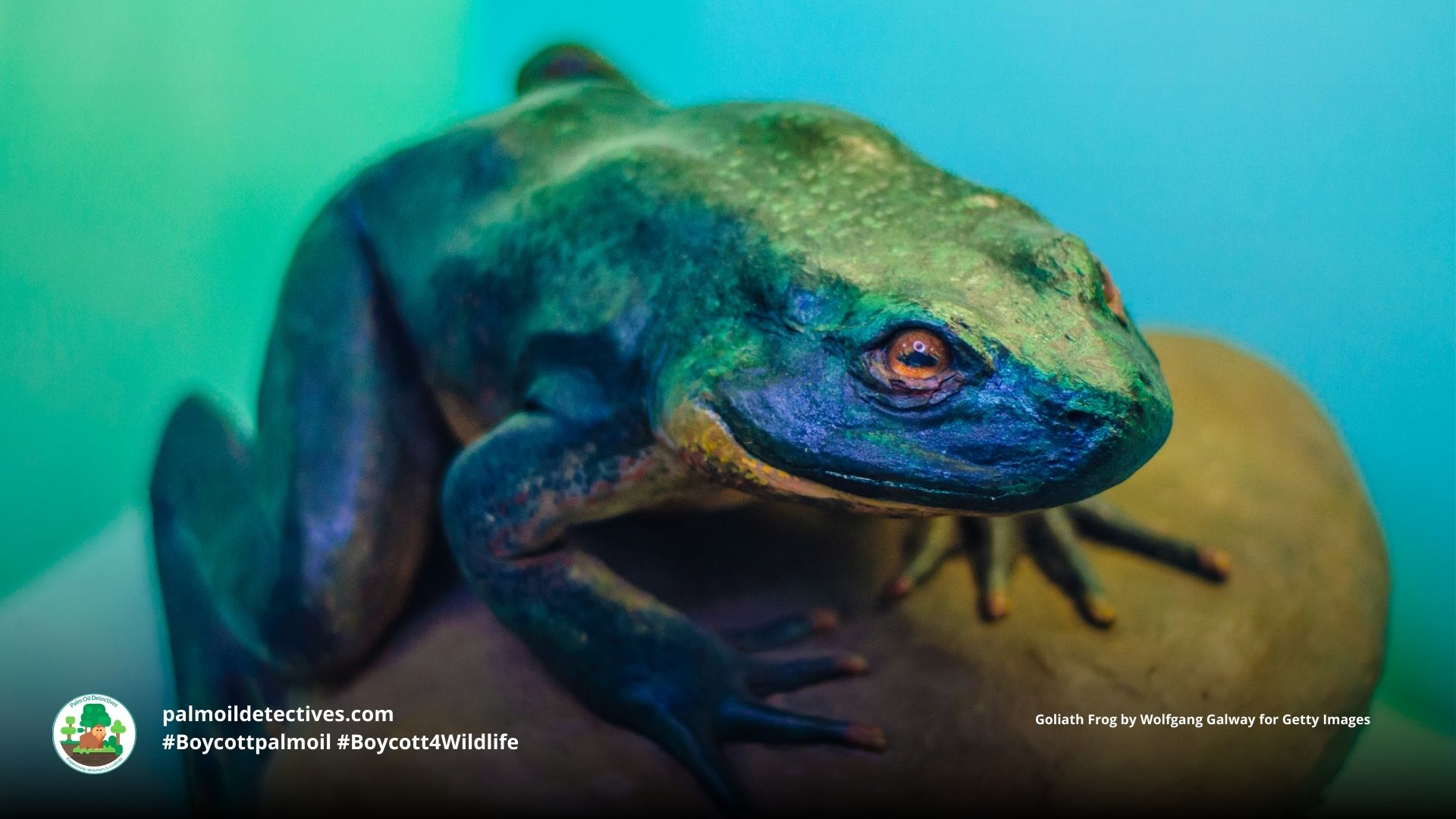
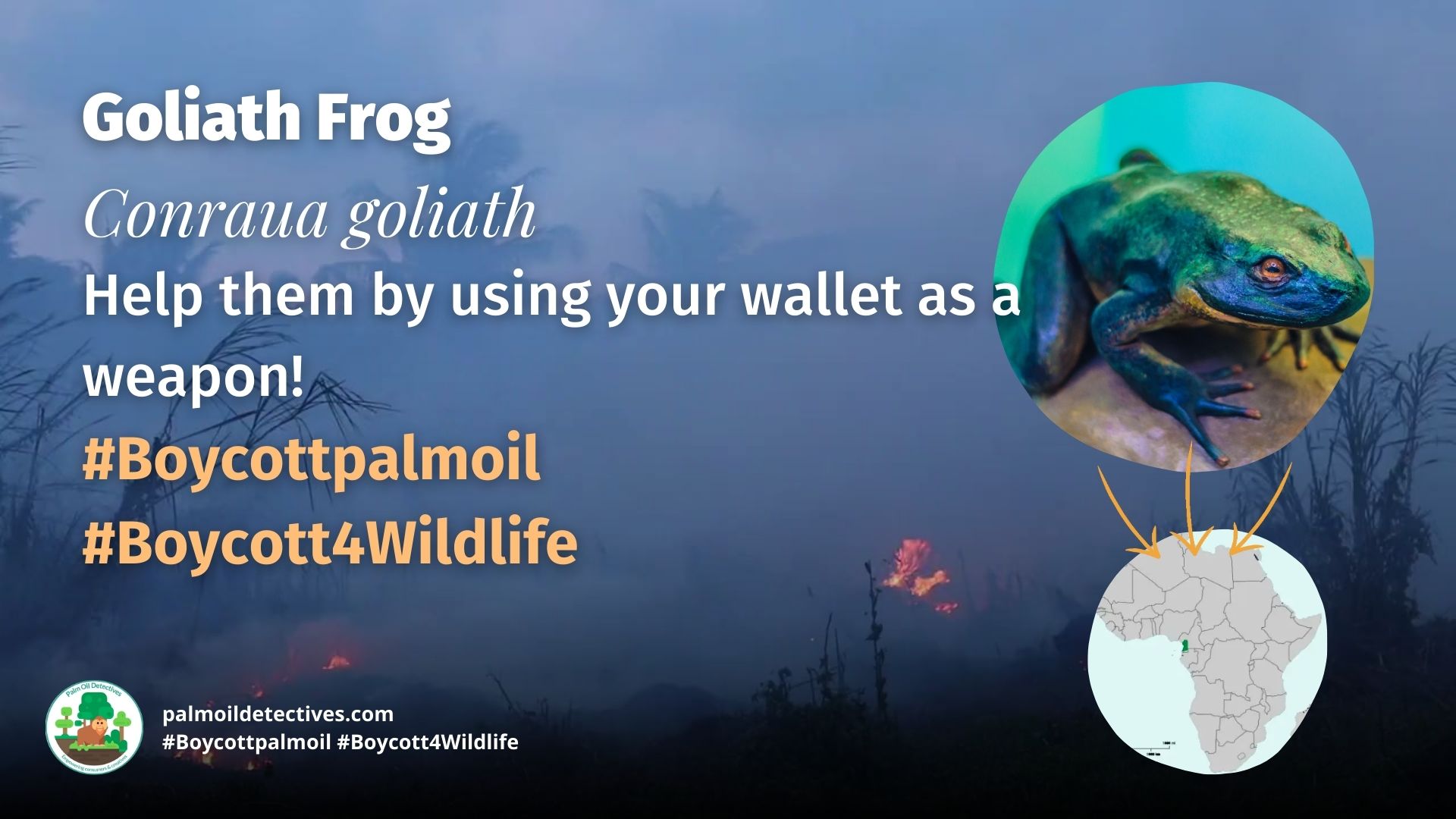
Geographic range
These frogs are typically found near fast flowing rivers with sandy bottoms in Cameroon and Equatorial Guinea. They may have now gone extinct in Gabon. They prefer clear and oxygenated water from clean rivers and streams in densely forested and humid parts of the rainforest. They typically stay in rivers during the heat of the day and will emerge onto land during the night time.
Goliath frogs don’t survive well in heavily degraded and deforested areas and prefer undisturbed forest, streams and fast-flowing rivers far away from villages.
Diet
Goliath tadpoles feed on a single aquatic plant Dicraeia warmingii which is found only in areas of clean oxygenated water close to waterfalls and fast-flowing rapids. This explains their range and serious vulnerability to extinction.
Adult goliath frogs are less fussy and will feed on multiple food sources including: baby turtles, young snakes, small mammals, bats, crustaceans, mollusks, fish, dragonflies, locusts, insects, spiders and worms.
Mating & reproduction
Unlike most other frogs, goliath frogs don’t have a vocal sac and therefore don’t call to their mates.
Goliath frogs create nesting sites for offspring – this is a form of parental care. Adult males will take their cue from the environment in order to build a nest that is going to be safest for their offspring. They have three kinds of nests.
Each nest type presents advantages and disadvantages depending on whether it is the dry or the rainy season and the presence or absence of predators of the eggs at different sites.
- rock pools cleared of leaf litter.
- Washouts at riverbanks.
- Depressions dug into the gravel of riverbanks.
The third kind of nest is arduous to create and is typically one metre in diameter. The building of this kind of nest requires brute strength for moving large rocks. It is thought that this is why goliath frogs are so large and muscular. Other extra large frog species such as gladiator frogs, bornean giant river frogs also perform this task.
The construction of nest is used by males as a way of demonstrating their prowess and reproductive fitness as mates to females. Males provide most of the parental investment in the eggs and nest building, whereas females will deposit the eggs after fertilisation and then depart afterwards. Larval development of eggs to tadpoles to frogs takes approximately 85-95 days.
Threats
The Goliath Frog is adversely affected by the loss of forest habitat for agriculture (including the creation of new cocoa plantations, banana plantations, and palm oil plantations), logging and human settlements.
Read more
Goliath frogs face multiple human-related threats, including:
- Agricultural pollution and run-off: Pesticides and chemicals used in palm oil and cocoa plantations in this region are toxic to Goliath frogs, who require clean rivers to reproduce.
- Industrial timber, palm oil, meat and cocoa deforestation
- Human consumption: Both for local subsistence and sold to bushmeat markets.
- Collection for the illegal pet trade: Animals are exported from Cameroon to Zoos in the USA and Europe. Although captive frogs live longer than their wild relatives, they are not able to breed in captivity.
Support Goliath Frogs by going vegan and boycotting palm oil in the supermarket, it’s the #Boycott4Wildlife
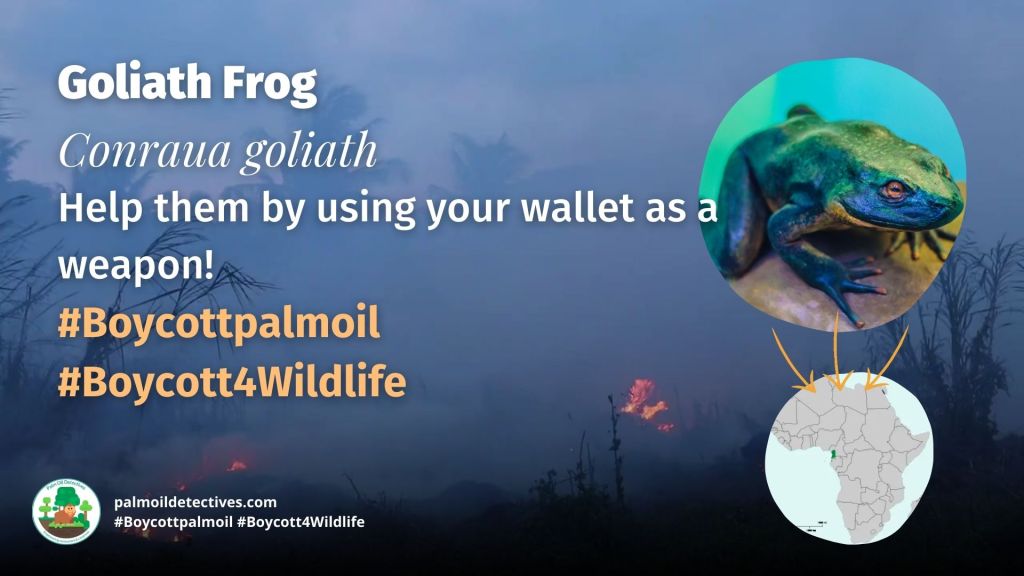
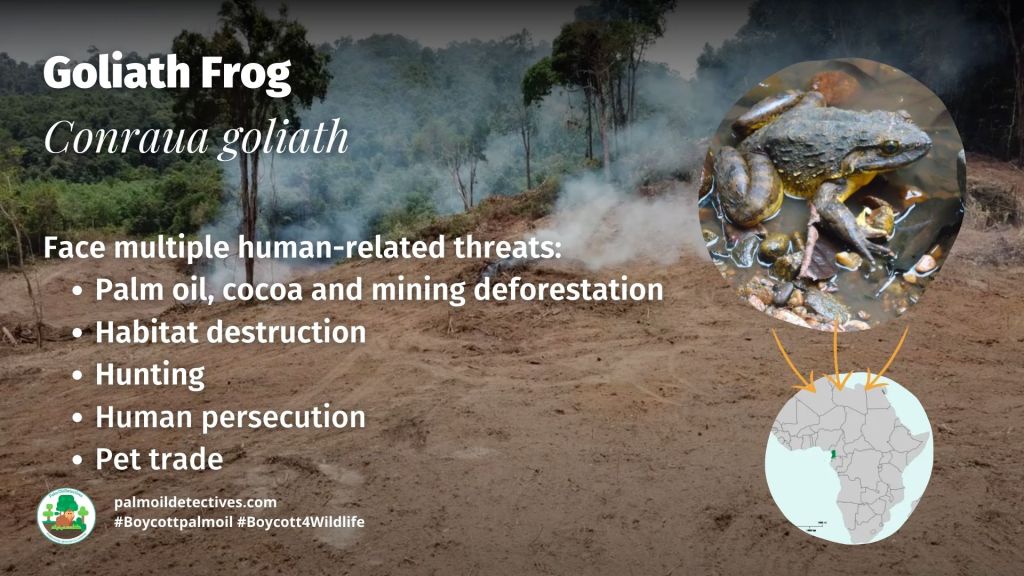
Support the conservation of this species
This animal has no protections in place. Read about other forgotten species here. Create art to support this forgotten animal or raise awareness about them by sharing this post and using the #Boycottpalmoil #Boycott4Wildlife hashtags on social media. Also you can boycott palm oil in the supermarket.
Further Information
IUCN SSC Amphibian Specialist Group. 2019. Conraua goliath. The IUCN Red List of Threatened Species 2019: e.T5263A96062132. https://dx.doi.org/10.2305/IUCN.UK.2019-1.RLTS.T5263A96062132.en. Accessed on 12 November 2022.
Marvin Schäfer, Sedrick Junior Tsekané, F. Arnaud M. Tchassem, Sanja Drakulić, Marina Kameni, Nono L. Gonwouo & Mark-Oliver Rödel (2019) Goliath frogs build nests for spawning – the reason for their gigantism?, Journal of Natural History, 53:21-22, 1263-1276, DOI: 10.1080/00222933.2019.1642528

How can I help the #Boycott4Wildlife?
Contribute in five ways
1. Join the #Boycott4Wildlife on social media and subscribe to stay in the loop: Share posts from this website to your own network on Twitter, Mastadon, Instagram, Facebook and Youtube using the hashtags #Boycottpalmoil #Boycott4Wildlife.
2. Contribute stories: Academics, conservationists, scientists, indigenous rights advocates and animal rights advocates working to expose the corruption of the palm oil industry or to save animals can contribute stories to the website.
3. Supermarket sleuthing: Next time you’re in the supermarket, take photos of products containing palm oil. Share these to social media along with the hashtags to call out the greenwashing and ecocide of the brands who use palm oil. You can also take photos of palm oil free products and congratulate brands when they go palm oil free.
4. Take to the streets: Get in touch with Palm Oil Detectives to find out more.
5. Donate: Make a one-off or monthly donation to Palm Oil Detectives as a way of saying thank you and to help pay for ongoing running costs of the website and social media campaigns. Donate here

